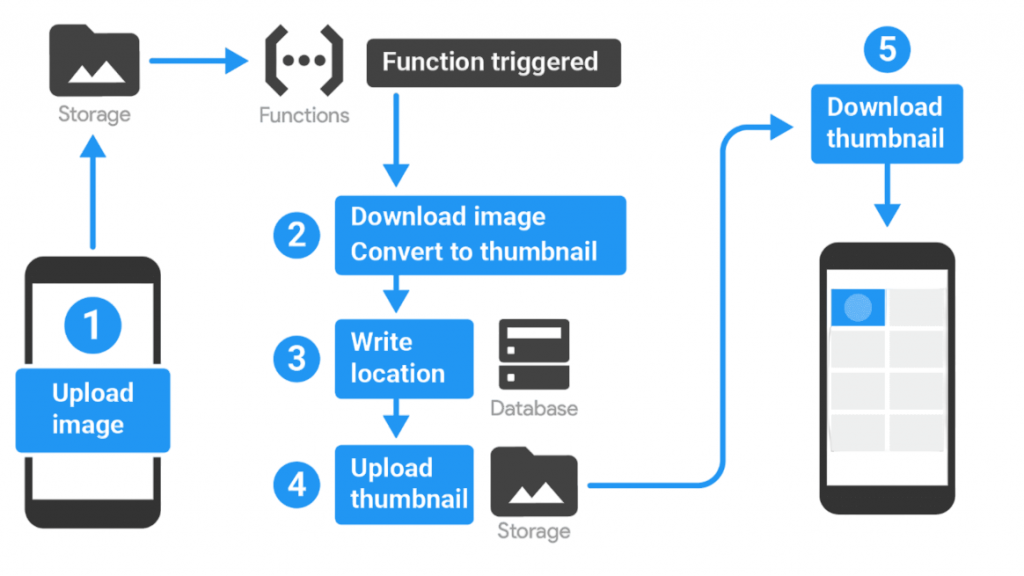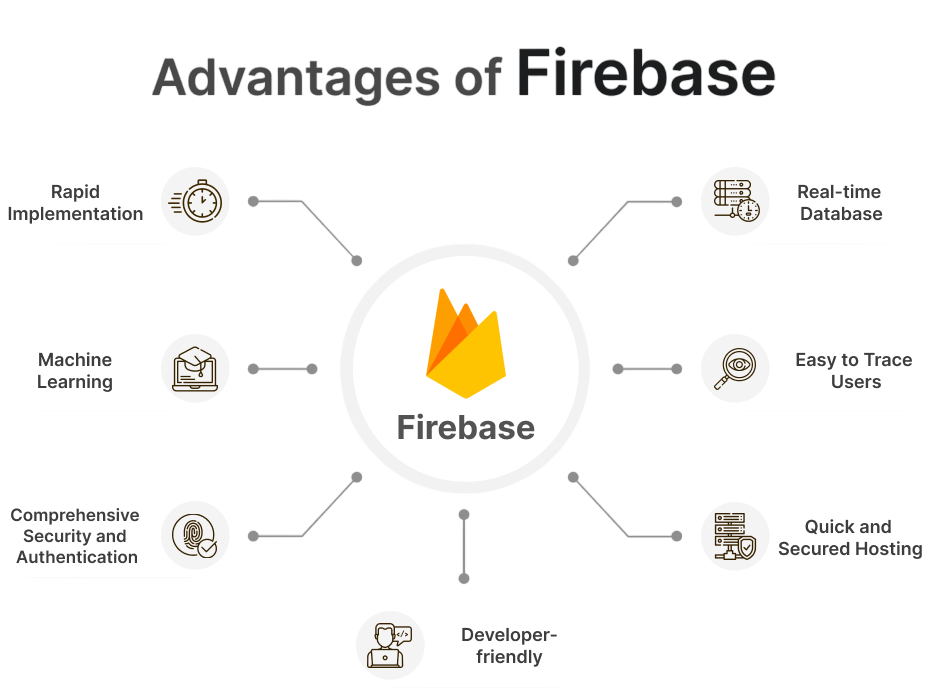
- What is Firebase Realtime Database?
- How Does Firebase Realtime Database Work?
- Key Features of Firebase
- Advantages of Firebase Realtime Database
- How to Integrate Firebase Realtime Database into Android
- Retrieve Data from Firebase Realtime Database in Android
- Considerations While Integrating Firebase Realtime Database
- Conclusion
What is Firebase Realtime Database?
Firebase Realtime Database meets the needs of web and mobile apps that require real-time updates. It acts as a cloud-based database, storing data in a flexible JSON-like format. This setup makes it easy to create, update, and delete data through simple API calls. The unique feature of this database is its ability to instantly synchronize data changes across all connected devices capabilities explored in Database Training, where learners gain practical experience with real-time data operations, cloud-integrated workflows, and scalable backend design. Mastering these techniques empowers developers to build responsive applications that maintain consistency across distributed environments. This allows for real-time collaboration and live updates. It also supports offline functionality. Your app can keep running without an internet connection, and any changes made while offline will sync once the connection is restored. To use Firebase Realtime Database, you need to integrate the Firebase SDK into your app. It provides libraries and tools for smooth communication between your app and the database.
To Explore Database in Depth, Check Out Our Comprehensive Database Online Training To Gain Insights From Our Experts!
How Does Firebase Realtime Database Work?
Firebase Realtime Database works in the following ways though when working with relational databases, understanding Types Of SQL Indexes is essential for optimizing query performance and data retrieval. Clustered indexes physically sort table rows, while non-clustered indexes create separate structures with pointers to the data. Choosing the right index type ensures efficient access patterns, especially when scaling applications that rely on structured, relational data models.
- Initialize Database: Create a Firebase project and enable the Realtime Database feature in the console.
- Define Rules: Set up security rules to restrict access and protect data. Configure read/write permissions based on authentication or other criteria.
- Structuring Data: Organize data using JSON-like tree structures with nodes representing key/value pairs. Define hierarchies and relationships among nodes.
- Read Data: Retrieve data using event listeners or one-off queries. Attach listeners to nodes for real-time updates and notifications.
- Write Data: Update data by assigning new values to specific nodes. Changes sync automatically across all connected devices.
- Handle Events: Manage value changes, child additions, deletions, and updates using callbacks or promises.
- Offline Capabilities: Supports offline persistence, allowing read/write access during disconnection. Sync resumes automatically upon reconnection.
- Scalability and Security: Built for high availability, scalability, and secure data handling. No manual intervention needed for replication or scaling.

Key Features of Firebase
Firebase is a powerful mobile and web development platform that offers several features that make it an excellent choice for real-time data management yet for developers working with document-based databases, mastering command-line operations is equally vital, as outlined in MongoDB Commands Cheat Sheet. From shell startup options to CRUD operations and index creation, this guide equips learners with essential MongoDB commands for efficient data handling, debugging, and performance tuning in scalable backend systems.
- Security and Authentication: Built-in security rules allow fine-grained access control. Integrates with Firebase Authentication for user verification and data protection.
- Real-Time Sync: Changes to the database are instantly reflected across all connected clients, ensuring consistent and up-to-date user experiences.
- Scalability: Efficiently handles high traffic and multiple users. Resources scale dynamically to support increased data loads and maintain performance.
- Offline Support: Enables applications to function without network connectivity. Data is stored locally and automatically synced upon reconnection.
- Automatic Backup and Restore: Provides automatic backups for data durability and easy recovery in case of loss or corruption.
- Create a Firebase Project: Go to the Firebase Console and create a new project to configure and initialize Firebase services.
- Add Firebase SDK: Integrate Firebase into your Android/iOS project by following platform-specific setup instructions.
- Establish Realtime Database: Enable the Realtime Database feature in the Firebase Console for your project.
- Initialize Firebase: Initialize the Firebase SDK in your app code to establish a reference to the Realtime Database.
- Create Database Structure: Design the layout of your database using nodes, paths, and hierarchical JSON-like organization.
- Read and Write Data: Use Firebase APIs and listeners to access and modify data in the Realtime Database.
- Handle Data Changes: Set up listeners to receive real-time updates when data changes within the database.
- Secure Your Database: Configure security rules in the Firebase Console to control access and ensure data integrity.
- Test and Deploy: Thoroughly test your app to validate Firebase integration before deploying to production.
- Monitor and Maintain: Regularly monitor integration status and apply updates or improvements for optimal performance.
- Scalability: Consider the scalability of your application and any expected growth in data volume. Optimize your Firebase Realtime Database structure and rules to allow for efficient retrieval and updates even with multiple concurrent users.
- Security: Treat data security and access control seriously. Utilize Firebase’s built-in security rules to set fine-grained permissions and authentication mechanisms. This ensures that only authorized users can read or write data.
- Data Structure Design: Carefully plan your database structure to enhance query performance. Avoid excessive nesting or duplicating data, as this can increase complexity and potential inconsistencies. Use denormalization and indexing strategies for better data retrieval.
Do You Want to Learn More About Database? Get Info From Our Database Online Training Today!
Advantages of Firebase Realtime Database
Firebase Realtime Database is a strong solution for developers who need effective, real-time data management for mobile and web applications. It offers automatic data synchronization and works well across different platforms. This database lets developers build dynamic applications that show updates instantly on connected devices. The platform integrates easily with its Software Development Kit (SDK), which simplifies backend management. This allows developers to concentrate on key application features. Additionally, Firebase offers real-time analytics that provide useful insights into user behavior and app performance capabilities explored in Database Training, where learners gain hands-on experience with cloud-integrated databases, performance monitoring, and scalable backend workflows. Understanding how SDKs streamline development and analytics enhances both productivity and data-driven decision-making. This helps teams make decisions based on data.

The platform supports many environments, including Web, iOS, Android, and Unity, ensuring a consistent user experience. One of the best features of Firebase is its ability to support quick prototyping. Developers can test and refine their ideas without the usual complications of managing servers. These features make Firebase Realtime Database an essential tool for modern application development, improving the process from idea to launch with great efficiency and flexibility.
How to Integrate Firebase Realtime Database into Android
To integrate Firebase Realtime Database into an Android/iOS app, follow these steps though if you’re aiming for long-term growth in data infrastructure roles, it’s essential to Start a Career in Database Administration. This guide walks learners through foundational skills like SQL, Oracle, and MySQL, while emphasizing certification paths, hands-on experience, and platform-specific knowledge. Whether you’re managing cloud-based NoSQL systems or traditional relational databases, mastering administration fundamentals ensures scalability, security, and performance across enterprise environments.
Would You Like to Know More About Database? Sign Up For Our Database Online Training Now!
Retrieve Data from a Firebase Realtime Database in Android
Integrating Firebase into your Android application starts by setting up a strong connection through the Firebase Console. Here, you’ll create a new project and add the Firebase Android SDK. After initialization, it’s important to configure the Real-Time Database a step that mirrors principles found in a Transaction Processing System, where consistent setup and predictable execution are key. TPS frameworks ensure atomicity, consistency, isolation, and durability (ACID), enabling real-time systems to process inputs reliably and maintain data integrity across concurrent operations and distributed environments. This involves enabling the service and defining security rules to manage data access. To retrieve data, developers need to create a DatabaseReference object by calling getReference() on the Firebase database instance. Then, they should attach a ValueEventListener to dynamically monitor database changes. This listener lets you override the onDataChange() method, giving you access to the retrieved data through the DataSnapshot object. This enables real-time data synchronization and manipulation within your Android application. By following these steps, developers can use Firebase’s real-time database features to create mobile experiences that update instantly and securely.
Considerations While Integrating Firebase Realtime Database
Addressing the concerns listed below will help ensure a smooth integration of Firebase Realtime Database into your application, providing a reliable and scalable real-time data management solution yet understanding backend connectivity remains essential, as outlined in MongoDB Port, where learners explore how default ports like 27017 facilitate communication between MongoDB clients and servers. Mastering port configuration and conflict resolution ensures stable deployment across distributed systems and avoids initialization failures due to port collisions.
Want to Learn About Database? Explore Our Database Interview Questions and Answers Featuring the Most Frequently Asked Questions in Job Interviews.
Conclusion
In conclusion, Firebase Realtime Database is a flexible and robust solution for developers and beginners looking to build real-time applications. With Firebase Realtime Database, developers can focus on creating innovative features while beginners gain practical experience building dynamic applications concepts reinforced in Database Training, where learners explore real-time data handling, schema design, and cloud-integrated workflows. By mastering both traditional relational models and modern NoSQL systems, developers gain the versatility to build scalable, responsive applications across platforms. By leveraging its functionalities, developers can concentrate on crafting advanced features while newcomers can enjoy hands-on experience building modern, real-time applications.


